Crab spiders are fascinating arachnids, known for their unique hunting techniques and striking appearance. Among the many species, the pink crab spider is one of the most intriguing due to its vibrant color and fascinating behavior. This article will provide a detailed look at the pink crab spider, including its habitat, behavior, and why it has become so popular among enthusiasts and researchers alike.
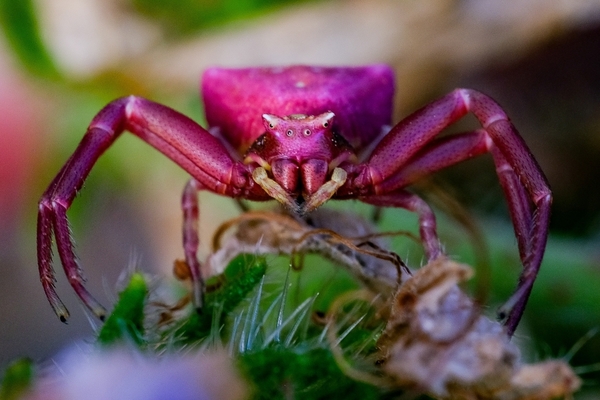
A pink crab spider is a variety of crab spider, belonging to the family Thomisidae, known for its ability to change color. The name "crab spider" comes from their distinctive walking style, which resembles the sideways scuttle of a crab. Unlike many other spiders that spin webs to catch prey, crab spiders are active hunters and typically ambush their prey. The pink crab spider is particularly famous for its pink coloration, which helps it blend in with flowers, where it often resides to hunt pollinators like bees and butterflies.
The pink crab spider is often identified as Misumena vatia, though not all crab spiders of this genus are pink. Other colors, such as white or yellow, are also common, depending on the environment.
Coloration: The pink crab spider is most notable for its pink or reddish-pink body, which can blend well with certain flowers, especially those with pink or white petals. Interestingly, these spiders can also change color to adapt to their surroundings, allowing them to shift from pink to white or yellow depending on the color of the flowers they are hunting on.
Size: Pink crab spiders are relatively small, with females typically measuring around 9-10 millimeters (0.35-0.39 inches) in length, and males being smaller at about 5-7 millimeters (0.20-0.28 inches).
Legs: As with other crab spiders, the pink crab spider has long, wide legs that help it move sideways, much like a crab. These legs are equipped with sharp claws that help it cling to flowers and other surfaces.
Eyes: They have eight eyes arranged in two rows, providing excellent vision for hunting and navigating their environment.
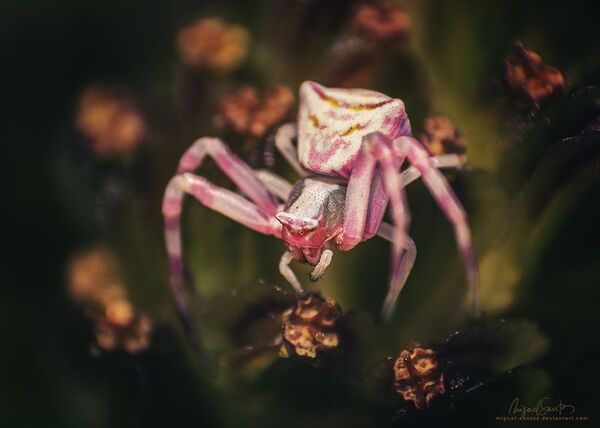
Pink crab spiders are primarily found in gardens, meadows, and flower-rich areas. They are often seen resting motionless on flowers, where they lie in wait for unsuspecting pollinators. Their coloration makes them masters of camouflage in such environments.
They do not build webs for hunting. Instead, they employ a sit-and-wait strategy, ambushing their prey by hiding on flower petals or leaves. Some species are capable of altering their color to match the flowers they are hiding on, increasing their chances of a successful hunt.
Common flowers they inhabit: Pink crab spiders are often found on flowers such as asters, daisies, chrysanthemums, and camellias.
Preferred climates: They thrive in temperate climates, where flowers bloom regularly throughout the warmer months.
The pink crab spider is an ambush predator. Unlike spiders that use webs to trap their prey, the crab spider relies on stealth and speed. Here’s how it hunts:
Luring prey: The spider sits motionless on a flower, using its camouflage to attract insects such as bees, flies, or butterflies.
Ambush attack: Once the prey comes close, the pink crab spider strikes quickly with its powerful front legs, grabbing the insect and injecting venom to paralyze or kill it.
Feeding: After immobilizing its prey, the spider feeds on it by injecting digestive enzymes into the insect’s body to liquefy the internal tissues, which it then consumes.
The pink crab spider's diet mainly consists of small insects and pollinators, making it a useful natural pest controller in gardens and fields.
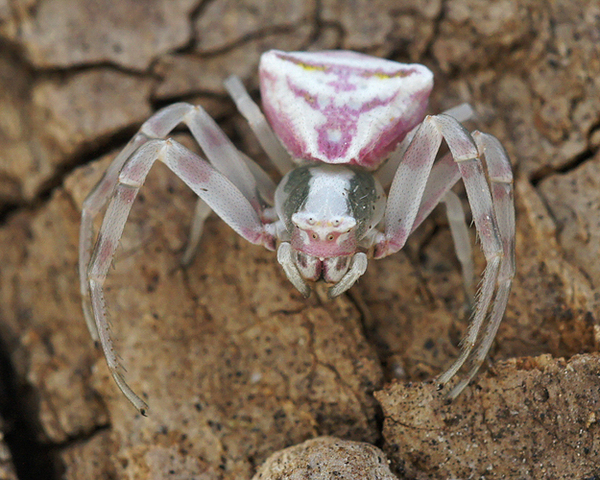
One of the most interesting aspects of the pink crab spider is its ability to change color. Although its primary color is pink, it can shift to white or yellow, which helps it blend into different types of flowers. This color change is triggered by environmental factors, such as the color of the flowers on which it is resting.
Color Change Mechanism: Pink crab spiders change their color through pigment cells in their skin. The process can take several days and helps the spider remain camouflaged, improving its chances of ambushing prey.
Aggression: Pink crab spiders are not aggressive towards humans. They are shy creatures that prefer to stay hidden and are unlikely to bite unless threatened. Even then, their bite is not harmful to humans, as their venom is meant to subdue small insects.
The reproductive cycle of pink crab spiders is quite fascinating. Here’s an overview:
Mating: Female crab spiders are larger than males, and during mating season, the males approach females cautiously, as they are at risk of being eaten. After mating, the female lays eggs in a small sac, which she guards until the spiderlings hatch.
Spiderlings: After hatching, the baby spiders are independent and begin hunting for themselves. They mature in a few months and will start the cycle again.
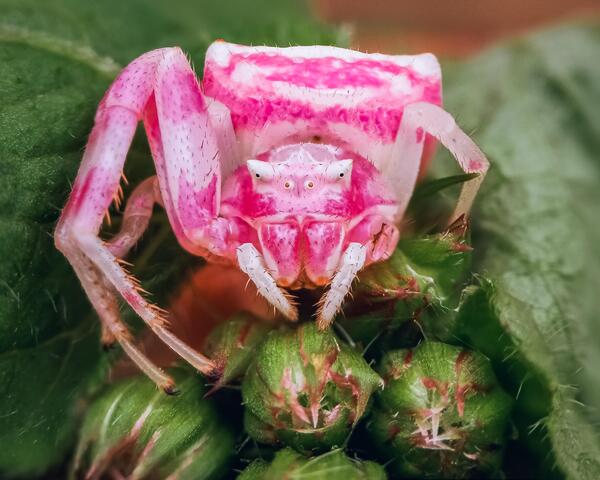
Despite their fierce appearance and predatory behavior, pink crab spiders are generally not dangerous to humans. Their venom is used to immobilize small prey, and while they may bite in self-defense, their bites are not harmful to humans. Some people may experience mild irritation or redness from a bite, but this is rare.
Attracting them: If you want to attract pink crab spiders to your garden (since they can be beneficial for pest control), plant flowers like asters, daisies, and chrysanthemums. Providing a variety of flowering plants will help draw pollinators, which in turn will attract crab spiders.
Repelling them: If you prefer to keep them away, avoid using insecticides, as these can harm the spiders. Additionally, removing flowers where they are often found can discourage them from inhabiting your garden.
Camouflage experts: The pink crab spider is a master of disguise. By adjusting its color to match its surroundings, it makes itself nearly invisible to both predators and prey.
Predator control: These spiders play an important role in controlling insect populations, particularly in flower-rich environments.
Incredible patience: These spiders can remain still for long periods, patiently waiting for the right moment to strike.
The pink crab spider is a beautiful and fascinating creature with remarkable abilities. From its vibrant, camouflaging color to its unique hunting techniques, this spider has earned a place in both nature’s ecosystem and the hearts of spider enthusiasts. While they are harmless to humans, they are incredibly effective predators in gardens and flowerbeds, helping control insect populations in a natural and eco-friendly way.
Whether you’re a gardener interested in natural pest control or a spider lover fascinated by their behavior, the pink crab spider is a remarkable creature to observe and learn about.
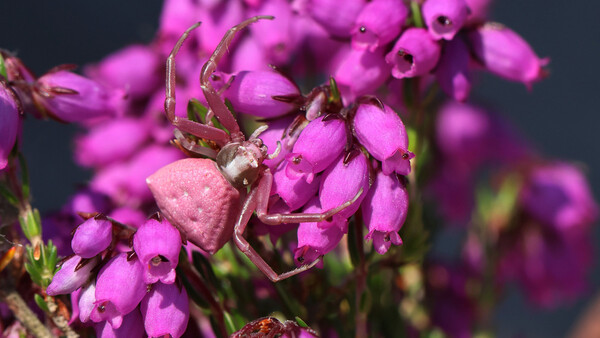
Crab spiders, known for their ability to ambush prey and blend in with their environment, come in a variety of species, some of which are pink or can change color to pink. These spiders belong to the Thomisidae family, and while many species can be found in various habitats, not all of them exhibit the pink coloration that makes them so distinctive. Below is a detailed look at the different types of pink crab spiders, including their key characteristics, habitat, and behavior.
| Species | Scientific Name | Key Characteristics | Color | Habitat | Behavior |
|---|---|---|---|---|---|
| Common Pink Crab Spider | Misumena vatia | Ability to change color, wide leg span, ambush predator | Primarily pink, but can turn white or yellow | Flowers, especially daisies and asters | Ambush predator, waits motionless on flowers to catch pollinators (bees, butterflies) |
| Golden Crab Spider | Misumena vatia (color morph) | Slightly larger body, color morphs | Pink, yellow, or white | Flowers in temperate regions, often on sunlit plants | Similar to the common pink crab spider, but more likely to turn yellow or white |
| Daisy Crab Spider | Misumena vatia | Smaller than others, slender body | Pink or white, sometimes yellow | Daisies, other flower-rich environments | Ambushes prey from flowers, excellent camouflage |
| Flower Crab Spider | Xysticus species | Similar appearance to Misumena vatia, but smaller | Pink to white | Various flowers, grasses, and shrubs | Predatory, hides on flowers, uses color to blend in and catch prey |
| White Crab Spider | Thomisus spectabilis | Can change color depending on the environment | White to pale pink | Shrubs, flowers, gardens | Prefers to stay on white flowers, ambushes pollinators by camouflaging |
| Yellow Crab Spider | Misumena vatia (color morph) | Can change color to yellow, larger body size | Pink or yellow, can change with environment | Common in gardens, meadows, and flower beds | Predatory, hides on flowers, similar to other crab spiders in behavior |
| Pink Orchid Crab Spider | Orthobula species | Adapted to hide in orchids | Pink or light-colored | Orchids, tropical environments | Ambush predator, blends in with orchid petals |

Common Pink Crab Spider (Misumena vatia)
Color: Typically pink, but can shift to white or yellow depending on the flower it inhabits.
Habitat: Found primarily on flowers such as asters, daisies, and chrysanthemums.
Behavior: Known for its ambush hunting strategy, this species sits motionless on flowers waiting for prey like bees or butterflies to come within striking distance. It can change color to better blend with its environment, providing excellent camouflage.
Unique Feature: Has a wide leg span, which helps it stay balanced while hiding in plain sight on flowers.
Golden Crab Spider (Misumena vatia, color morph)
Color: This variant often exhibits a golden yellow color but can also be pink or white.
Habitat: Found in temperate regions, especially on sunlit flowers.
Behavior: Similar to the common pink crab spider, this species also uses ambush tactics. It’s often seen on bright yellow flowers, providing an excellent example of the spider's ability to adapt to its environment.
Unique Feature: Tends to stay in warmer, more open areas where it can make use of sunlight for warmth.
Daisy Crab Spider (Misumena vatia)
Color: This spider can be pink, white, or even yellow depending on the flowers it resides on.
Habitat: Prefers daisies and similar flowers, making it easy to spot in gardens and flower beds.
Behavior: Like the other crab spiders, the daisy crab spider waits for pollinators. Its small size and slender body allow it to blend in perfectly with the delicate petals of daisies.
Unique Feature: Often mistaken for other species due to its similar appearance, but its size and habitat make it stand out in floral environments.
Flower Crab Spider (Xysticus species)
Color: Varies from pink to white and sometimes yellow.
Habitat: Found on various flowers, grasses, and shrubs.
Behavior: A predatory spider that hides on flowers to ambush passing insects. It uses its color-changing ability to blend with different flower types.
Unique Feature: Smaller than the Misumena vatia species, but still a skilled ambush predator with excellent camouflage.
White Crab Spider (Thomisus spectabilis)
Color: Predominantly white, with some color morphs that can appear pale pink.
Habitat: Commonly found in gardens and areas with white or pale-colored flowers.
Behavior: This species is known for its ability to remain hidden on white flowers, using its white coloration for perfect camouflage. It hunts by ambushing insects that land on the flowers it resides on.
Unique Feature: While it is not always pink, it can shift to a pale pinkish hue in certain environments.
Yellow Crab Spider (Misumena vatia, color morph)
Color: This spider can be either pink or yellow, depending on the flower it chooses to hide on.
Habitat: Found in a variety of garden and meadow environments, often in places where flowers bloom in yellow or bright colors.
Behavior: Similar to the other Misumena species, the yellow crab spider uses ambush tactics to capture pollinators.
Unique Feature: The ability to change color based on its surroundings is a key feature of this species, enhancing its camouflage.
Pink Orchid Crab Spider (Orthobula species)
Color: The pink orchid crab spider has a light pink coloration that blends well with the petals of orchids.
Habitat: This species is mostly found in tropical environments, specifically on orchids.
Behavior: It uses the same ambush method to capture prey. Its ability to hide in orchids makes it well-suited to ambushing smaller pollinators like bees.
Unique Feature: This species is particularly adapted to the tropical environment and is often seen on orchid flowers, where it camouflages perfectly.
The pink crab spider is an incredibly diverse group of spiders that exhibit remarkable camouflage and predatory skills. They use their ability to change color, from pink to white or yellow, to blend in with their surroundings and ambush unsuspecting prey. These spiders are found in a variety of habitats, from temperate gardens to tropical regions, and play an important role in controlling insect populations. Whether it's the common Misumena vatia or the more exotic Orthobula species, pink crab spiders are a fascinating group to observe and learn about.
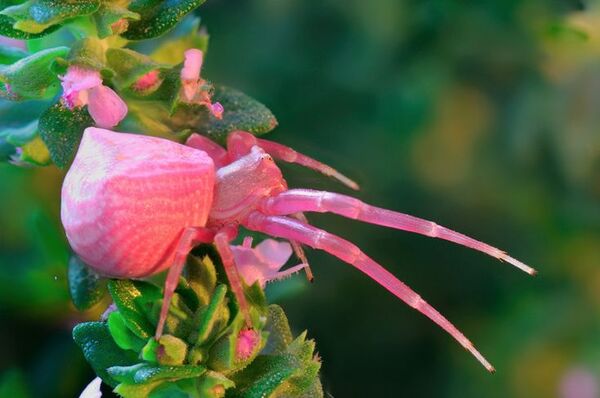
While the pink crab spiders are skilled predators, their venom is not dangerous to humans. These spiders use their venom to immobilize and digest small prey such as bees, flies, and other insects. However, their venom is mild, and even though it can cause minor irritation or localized swelling in some people, it's not lethal or capable of causing serious harm.
Venom Type: Neurotoxic, which helps immobilize small prey.
Effect on Humans: Typically causes mild symptoms like redness, swelling, or minor pain at the site of a bite.
Effect on Pets: A bite from a pink crab spider is unlikely to cause serious harm to pets like cats or dogs, though there could be local irritation if bitten.
Treatment for Bites: If bitten, wash the area with soap and water, apply a cold compress to reduce swelling, and, if necessary, take over-the-counter antihistamines or pain relievers. Consult a doctor if the symptoms worsen.
The pink crab spider's venom, though potent to its prey, is generally not something to be overly concerned about in a human or pet context.
Crab spiders, including the pink varieties, are not commonly kept as pets in the same way as other species like tarantulas or jumping spiders. While they are fascinating and have unique behaviors, there are several reasons why they are not ideal as household pets for most people:
Care Requirements:
Feeding: Pink crab spiders are ambush predators, which means they require live prey like flies, bees, or other small insects. Regularly feeding them can be more complicated than other pet spiders that accept pre-killed food.
Habitat: They need specific environments such as flowers or plants that mimic their natural surroundings. Providing this in a captive environment can be challenging, as they also need a consistent temperature and humidity.
Temperament:
Shy and Reclusive: Crab spiders, including the pink varieties, are typically shy and reclusive. They spend most of their time sitting motionless, blending in with their surroundings. This makes them less interactive compared to other pet spiders that can be handled or observed more easily.
Defensive: While not aggressive, they might bite if provoked. Their venom is not harmful to humans but can cause mild irritation, so handling is generally discouraged.
Size and Lifespan:
Size: Crab spiders are generally small, and while some species, like Misumena vatia, can grow up to about 1 inch (2.5 cm) in body length, they remain fairly small and compact compared to other pet spiders.
Lifespan: The lifespan of a pink crab spider is typically 1-2 years in captivity. This short lifespan makes them less desirable as long-term pets compared to other species that can live for several years.
Handling:
Crab spiders are not suitable for handling due to their small size and delicate nature. Regular interaction can cause stress, and they may bite if they feel threatened, though this is rare.
While pink crab spiders are not typically chosen as pets, some other species of crab spiders and small spiders can be more suitable for beginners or enthusiasts:
Tarantulas (e.g., Mexican Redknee, Chilean Rose): Larger, easier to handle, and more interactive than crab spiders.
Jumping Spiders (e.g., Phidippus audax): Smaller than tarantulas but known for their curiosity and relatively easy care, jumping spiders are also more suitable for pet owners interested in spiders.
Flower Crab Spiders (e.g., Misumena vatia): While not the most common pet, some people do keep species like Misumena vatia (the flower crab spider) as pets. This species tends to be easier to care for in controlled environments like small enclosures with plants.
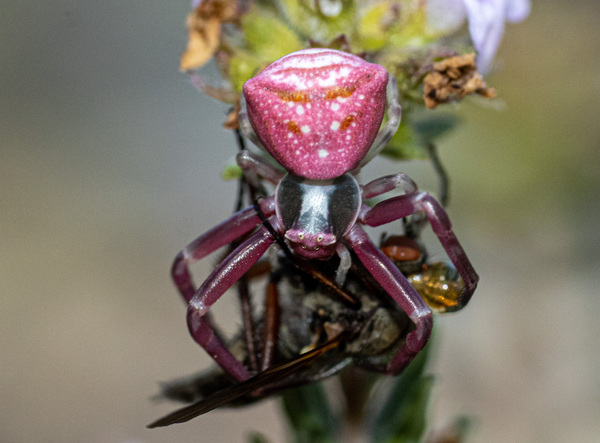
If you're determined to keep a pink crab spider as a pet, here's a basic guideline for their care:
Enclosure:
Use a small terrarium or enclosure (around 10 to 20 gallons). Ensure the environment has plenty of plants or flowers for the spider to hide in.
Maintain appropriate temperature (around 70–80°F or 21–27°C) and humidity (around 60-70%).
Feeding:
Feed the spider live prey such as small flies, bees (if it's safe and ethical), or crickets. Be sure not to overfeed as they are ambush predators and only need food occasionally.
Ensure the prey is proportionate to the size of the spider, as very large insects can overwhelm or harm it.
Water:
Provide a small water dish with shallow water. Be sure the spider has access to fresh water at all times.
Handling:
Avoid handling the spider to prevent stress. Keep it in a safe, quiet area where it can hunt undisturbed.
Health:
Watch for signs of illness or injury. If the spider appears lethargic or stops eating, it may require a change in environmental conditions or diet.
Cleaning:
Clean the enclosure regularly, but avoid disturbing the spider too much during this process.
In summary, while pink crab spiders are fascinating creatures with their ability to change color and ambush prey, they are not the most suitable pet for most people due to their specialized care needs and low level of interaction. They have mild venom, which doesn't pose a significant threat to humans or pets, but they are better appreciated as observational creatures in the wild or in controlled environments where they can hunt naturally. For those looking to keep a spider as a pet, species like tarantulas, jumping spiders, and other more interactive species are generally better choices.
animal tags: pink-crab-spiders
We created this article in conjunction with AI technology, then made sure it was fact-checked and edited by a Animals Top editor.